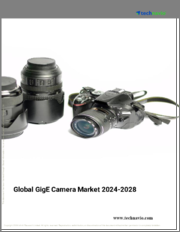
|
시장보고서
상품코드
1364869
GigE 카메라 시장 : 현황 분석과 예측(2023-2030년)GigE Camera Market: Current Analysis and Forecast (2023-2030) |
||||||
GigE 카메라 시장의 2022년 시장 규모는 15억 달러로, 고속 접속성, 비용 효과, 범용성, 화질 향상에 대한 수요의 증가로 인해 예측 기간(2023-2030년)에는 약 9.5%의 안정된 성장이 전망됩니다. 또한 IoT의 성장으로 인해 카메라를 포함한 커넥티드 디바이스의 수가 증가하고 있으며, GigE 카메라는 네트워크에 쉽게 연결할 수 있고 인터넷을 통해 데이터를 전송할 수 있으며, IoT 용도에 적합합니다. 예를 들어 2021년 FLIR는 고해상도 열화상 이미지를 촬영할 수 있는 GigE 카메라 FLIR A60 열화상 카메라를 출시했습니다. 이 카메라는 산업용, 상업용 및 일반 소비자용으로 설계되었으며, NVR 및 엣지 컴퓨팅 시스템과 같은 다른 장비와 통합할 수 있습니다.
기술별로 보면 시장은 전하결합소자(CCD)와 직원 옹호 소프트웨어 시장(CMOS)으로 나뉩니다. 이 중 CMOS 분야가 GigE 카메라 시장을 주도하고 있습니다. CMOS 이미지 센서의 주요 장점 중 하나는 CCD 이미지 센서에 비해 전력 소모가 적다는 점인데, 이는 산업 자동화, 의료용 이미지 처리, 보안 감시 등 다양한 용도에서 CMOS 이미지 센서의 채택이 증가하고 있기 때문입니다. 따라서 소비전력이 중요한 스마트폰, 드론, 보안 카메라 등 배터리로 구동되는 기기에 사용하기에 적합합니다.
스펙트럼에 따라 시장은 흑백 카메라, 컬러 카메라, 근적외선(NIR) 카메라, 자외선(UV) 카메라로 나뉩니다. 이 중 흑백 카메라 분야가 GigE 카메라 시장을 주도하고 있습니다. 흑백 카메라는 컬러 카메라에 비해 저렴한 비용과 높은 감도로 인기를 끌고 있습니다. 흑백 카메라는 고속, 고해상도 영상이 요구되는 산업 자동화, 의료용 영상 처리, 과학 연구 분야에서 널리 사용되고 있습니다. 이러한 산업에서 흑백 카메라의 채택이 증가하면서 GigE 카메라 시장에서 흑백 카메라 분야의 성장을 주도하고 있습니다. 또한 높은 다이나믹 레인지와 저노이즈 성능을 갖춘 고급 흑백 센서의 개발은 이 부문의 성장을 더욱 촉진할 것으로 예상됩니다.
용도별로는 자동차, 군/국방, 식품/포장, 제약, 보안/감시, 의료, 산업, 기타로 구분됩니다. 그 중에서도 제조, 물류, 품질 관리 등 다양한 산업 분야에서 폭넓게 활용되고 있으며, 산업 분야가 GigE 카메라 시장을 주도하고 있으며, GigE 카메라는 검사, 모니터링, 자동화 등의 목적으로 산업 현장에서 고품질 이미지와 동영상을 촬영하는 데 사용되고 있습니다. 제품 결함 검사, 재고 추적, 생산 공정 모니터링 등에 사용됩니다. 산업 현장의 자동화 및 효율성에 대한 수요가 증가함에 따라 GigE 카메라의 채택이 증가하고 있으며, GigE 카메라 시장의 산업 분야가 성장하고 있습니다.
GigE 카메라 시장 도입에 대한 이해를 돕기 위해 북미(미국, 캐나다, 기타 북미), 유럽(독일, 영국, 프랑스, 프랑스, 스페인, 이탈리아, 기타 유럽), 아시아태평양(중국, 일본, 인도, 기타 아시아태평양), 기타 지역(중국, 일본, 인도, 기타 아시아태평양) 및 기타 지역으로 시장을 분석했습니다. 세계 각 지역에서의 존재감을 기준으로 분석되었습니다. 북미는 이 지역에 다수의 대기업이 존재하고, 자동차, 헬스케어, 제조 등 다양한 산업에서 첨단 영상 처리 기술에 대한 수요가 증가하고 있으며, 머신비전, 로봇 공학 등 첨단 기술 채택률이 높아 GigE 카메라 시장을 주도할 것으로 예상됩니다. 예측되고 있습니다. 또한 이 지역은 연구개발에 집중하고 있으며, 이는 첨단 이미징 기술 및 솔루션 개발로 이어지고 있습니다. 또한 산업 자동화, 의료용 영상 처리, 보안 감시 등 다양한 분야에서 GigE 카메라의 채택이 증가하고 있는 것도 북미 GigE 카메라 시장의 성장을 촉진하고 있습니다.
목차
제1장 시장 서론
- 시장의 정의
- 주요 목표
- 이해관계자
- 제한사항
제2장 조사 방법 또는 전제 S
- 조사 프로세스
- 조사 방법
- 응답자 개요
제3장 시장 요약
제4장 주요 요약
제5장 COVID-19가 GigE 카메라 시장에 미치는 영향
제6장 GigE 카메라 시장 매출, 2020-2030년
제7장 테크놀러지별 시장 인사이트
- 전하결합소자(CCD)
- 직원 옹호 소프트웨어 시장(CMOS)
제8장 스펙트럼별 시장 인사이트
- 모노크롬 카메라
- 컬러 카메라
- 근적외선(NIR) 카메라
- 자외선(UV) 카메라
제9장 애플리케이션별 시장 인사이트
- 자동차
- 군과 방위
- 식품과 포장
- 의약품
- 보안과 감시
- 의학
- 산업용
- 기타
제10장 지역별 시장 인사이트
- 북미
- 미국
- 캐나다
- 기타 북미 지역
- 유럽
- 독일
- 영국
- 프랑스
- 이탈리아
- 스페인
- 기타 유럽 지역
- 아시아태평양
- 중국
- 일본
- 인도
- 기타 아시아태평양
- 세계의 기타 지역
제11장 GigE 카메라 시장 역학
- 시장 촉진요인
- 시장이 해결해야 할 과제
- 영향 분석
제12장 GigE 카메라 시장 기회
제13장 GigE 카메라 시장 동향
제14장 수요측과 공급측 분석
- 수요측 분석
- 공급측 분석
제15장 밸류체인 분석
제16장 가격 분석
제17장 전략적 인사이트
제18장 경쟁 시나리오
- 경쟁 구도
- Porter's Five Forces 분석
제19장 기업 개요
- Allied Vision Technologies GmbH
- Basler AG
- Baumer
- IMPERX, Inc
- Zebra Technologies Corporation.
- Omron Corporation
- Qualitas Technologies.
- Sony Corporation
- Teledyne Digital Imaging Inc.
- Canon
제20장 면책사항
KSA 23.10.30A GigE Camera is a high-speed digital camera that uses the Gigabit Ethernet (GigE) networking standard to transmit image data to a computer. It typically has a resolution of 1080p or higher and can capture images at a rate of up to 30 frames per second. GigE cameras are often used in industrial and scientific applications, such as machine vision, medical imaging, and scientific research, because of their high resolution, low latency, and high data transfer rates.
The GigE Camera Market was valued at USD 1.5 billion in 2022 and is expected to grow at a steady rate of around 9.5% in the forecasted period (2023-2030) owing to the growing demand for high-speed connectivity, cost-effectiveness, versatility, and improved image quality. Moreover, the growth of the IoT has led to an increase in the number of connected devices, including cameras. GigE cameras are well-suited for IoT applications as they can easily connect to a network and transmit data over the internet. For instance, in 2021, FLIR Systems launched the FLIR A60 Thermal Imaging Camera, a GigE camera that can capture high-resolution thermal images. The camera was designed for industrial, commercial, and consumer applications, and can be integrated with other devices such as NVRs and edge computing systems.
Based on technology, the market is bifurcated into charged coupled device (CCD), and employee advocacy software market (CMOS). Among these, the CMOS segment is leading the GigE camera market. This is due to the increasing adoption of CMOS image sensors in a wide range of applications, including industrial automation, medical imaging, and security surveillance. One of the key advantages of CMOS image sensors is their lower power consumption compared to CCD image sensors. This makes them ideal for use in battery-powered devices, such as smartphones, drones, and security cameras, where power consumption is a critical factor.
Based on spectrum, the market is categorized into monochrome camera, color camera, near infrared (NIR) camera, ultraviolet (UV) camera. Among these, the monochrome camera segment is leading the GigE Camera market. Monochrome cameras are gaining popularity due to their lower cost and higher sensitivity compared to color cameras. They are widely used in industrial automation, medical imaging, and scientific research applications where high-speed and high-resolution images are required. The increasing adoption of monochrome cameras in these industries is driving the growth of the monochrome camera segment in the GigE Camera market. Additionally, the development of advanced monochrome sensors with high dynamic range and low noise performance is expected to further boost the growth of this segment.
Based on applications, the market is segmented into automotive, military & defense, food & packaging, pharmaceutical, security & surveillance, medical, industrial, and others. Among these, the industrial segment is leading the GigE Camera market, as it has a wide range of applications in various industries such as manufacturing, logistics, and quality control. GigE cameras are used in industrial settings to capture high-quality images and videos for inspection, monitoring, and automation purposes. They are used to inspect products for defects, track inventory, and monitor production processes. The growing demand for automation and efficiency in industrial settings has driven the adoption of GigE cameras, which has resulted in the growth of the industrial segment in the GigE Camera market.
For a better understanding of the market adoption of GigE camera, the market is analyzed based on its worldwide presence in countries such as North America (U.S., Canada, and the Rest of North America), Europe (Germany, U.K., France, Spain, Italy, Rest of Europe), Asia-Pacific (China, Japan, India, Rest of Asia-Pacific), Rest of World. North America is anticipated to lead the GigE Camera Market due to factors such as the presence of a large number of leading players in the region, the growing demand for advanced imaging technologies in various industries such as automotive, healthcare, and manufacturing, and the high adoption of advanced technologies such as machine vision and robotics. Additionally, the region has a strong focus on research and development, which has led to the development of advanced imaging technologies and solutions. Furthermore, the increasing adoption of GigE cameras in various applications such as industrial automation, medical imaging, and security surveillance is also driving the growth of the GigE Camera Market in North America.
Some of the major players operating in the market include: Allied Vision Technologies GmbH; Basler AG; Baumer; IMPERX, Inc; Zebra Technologies Corporation.; Omron Corporation; Qualitas Technologies.; Sony Corporation; Teledyne Digital Imaging Inc.; Canon.
TABLE OF CONTENTS
1 MARKET INTRODUCTION
- 1.1. Market Definitions
- 1.2. Main Objective
- 1.3. Stakeholders
- 1.4. Limitation
2 RESEARCH METHODOLOGY OR ASSUMPTIONS
- 2.1. Research Process of the GigE Camera Market
- 2.2. Research Methodology of the GigE Camera Market
- 2.3. Respondent Profile
3 MARKET SYNOPSIS
4 EXECUTIVE SUMMARY
5 IMPACT OF COVID-19 ON THE GIGE CAMERA MARKET
6 GIGE CAMERA MARKET REVENUE (USD MN), 2020-2030F
7 MARKET INSIGHTS BY TECHNOLOGY
- 7.1. Charged Coupled Device (CCD)
- 7.2. Employee Advocacy Software Market (CMOS)
8 MARKET INSIGHTS BY SPECTRUM
- 8.1. Monochrome Camera
- 8.2. Color Camera
- 8.3. Near Infrared (NIR) Camera
- 8.4. Ultraviolet (UV) Camera
9 MARKET INSIGHTS BY APPLICATIONS
- 9.1. Automotive
- 9.2. Military & Defence
- 9.3. Food & Packaging
- 9.4. Pharmaceutical
- 9.5. Security & Surveillance
- 9.6. Medical
- 9.7. Industrial
- 9.8. Others
10 MARKET INSIGHTS BY REGION
- 10.1. North America
- 10.1.1. U.S.
- 10.1.2. Canada
- 10.1.3. Rest of North America
- 10.2. Europe
- 10.2.1. Germany
- 10.2.2. U.K.
- 10.2.3. France
- 10.2.4. Italy
- 10.2.5. Spain
- 10.2.6. Rest of Europe
- 10.3. Asia-Pacific
- 10.3.1. China
- 10.3.2. Japan
- 10.3.3. India
- 10.3.4. Rest of Asia-Pacific
- 10.4. Rest of the World
11 GIGE CAMERA MARKET DYNAMICS
- 11.1. Market Drivers
- 11.2. Market Challenges
- 11.3. Impact Analysis
12 GIGE CAMERA MARKET OPPORTUNITIES
13 GIGE CAMERA MARKET TRENDS
14 DEMAND AND SUPPLY-SIDE ANALYSIS
- 14.1. Demand Side Analysis
- 14.2. Supply Side Analysis
15 VALUE CHAIN ANALYSIS
16 PRICING ANALYSIS
17 STRATEGIC INSIGHTS
18 COMPETITIVE SCENARIO
- 18.1. Competitive Landscape
- 18.1.1. Porters Fiver Forces Analysis
19 COMPANY PROFILED
- 19.1. Allied Vision Technologies GmbH
- 19.2. Basler AG
- 19.3. Baumer
- 19.4. IMPERX, Inc
- 19.5. Zebra Technologies Corporation.
- 19.6. Omron Corporation
- 19.7. Qualitas Technologies.
- 19.8. Sony Corporation
- 19.9. Teledyne Digital Imaging Inc.
- 19.10. Canon













